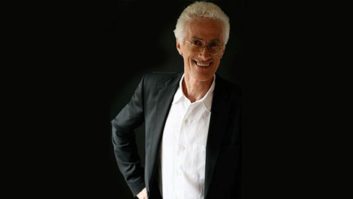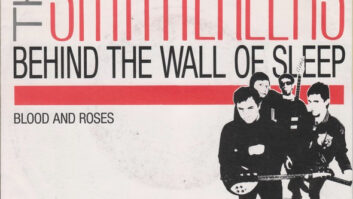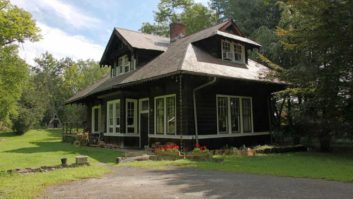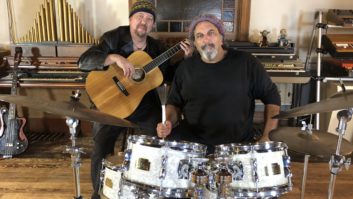Singer/songwriter Suzanne Vega is best known for her social commentary in the hit “Luka,” bittersweet, poetic lyrics in “Marlene on the Wall,” and the offbeat FM favorite “Left of Center.” Over the course of a handful of albums and years of touring, she has established herself as a modern bohemian, who has blended folk with an urban, sometimes detached perspective. One might consider her a link between pioneers of modern folk such as Judy Collins, Joni Mitchell and Joan Baez, and younger artists like Liz Phair and Jewel.
For a few years in the late ’90s, however, Vega maintained a fairly low profile, as she was deeply involved with personal matters. Some of these concerns form the heart of her sixth and latest CD, Songs in Red and Gray, which is arguably her most intimate album to date. “It’s a very direct album and it’s pretty personal, compared to some of the other albums I’ve made,” Vega explains from her Manhattan apartment.
“There are no issues on this one that you can point to,” she continues. “Really, it’s more of a group of songs about looking back, remembering certain parts of my life, including my recent separation [from producer/keyboardist Mitchell Froom]. And how you get your life together after you’ve been through something like that. I’m hoping [the CD] will be comforting to someone who’s been through a trauma or something.”
Naturally, Vega is very proud of the new release and feels that it showcases her songwriting development and maturity. She thinks the song called “Penitent” is the most poignant of the 13-song collection. “I’m just always in the mood to sing that one,” she says. “I guess it sums up the stance of the whole album. When you hear that, you can say, ‘Okay, that’s the mood she was in when she was writing this album.’ But [the new CD] actually is a good mixture of light and dark.”
The other notable aspect of Vega’s latest project is its acoustic orientation. Some would say it’s a back-to-basics approach that recaptures her folky Greenwich Village days in the early ’80s. Without question, this record is quite a contrast sonically to her previous two highly produced CDs, 99.9° F and Nine Objects of Desire, both done with her acclaimed ex-husband. Vega notes, “I always liked working with him; I don’t regret that part at all.
“But I thought that it would be a mistake to either avoid what I had done [with Froom] or try to re-create it. So, we just kind of stepped aside from that whole issue. I felt that all I really wanted to do was get back to basics. I had been doing some shows where it was me just playing acoustic guitar with my bass player, and I was really enjoying the intimacy and immediateness of that. So I said, ‘Let’s have this be an acoustic-based album.’ But I still wanted it to be fully produced and realized, unlike a ‘live’ or ‘roots’ CD.”
British producer Rupert Hine, a singer/songwriter in his own right with 11 solo CDs under his belt, turned Vega’s desires into a tangible recording. He, too, was going through a separation and divorce during the sessions, and had done two preliminary tracks as a demo with her three months before they started working together full-tilt. Vega was impressed and tapped him to produce the whole album. And although he’s produced dozens of records, ranging from the hard rocking Rush to pop/soul diva Tina Turner, Hine considers his work with singer/songwriters to be his true niche. “[Suzanne] really wanted to bring the acoustic guitar back so that she could play all the songs on her own, if need be,” he says from the Jim Henson Studios [formerly the site of A&M Records] in Los Angeles, where he was preparing for a new project.
Besides the acoustic orientation, there was one additional condition that Vega sought, which affected the whole recording process: She didn’t want the sessions to consume and upset her regular life, especially pertaining to Ruby, her young daughter. “We set up a way of working so that she could appear at a specific time every day,” says the producer. “That worked out to be about two to three in the afternoon, to about five or six in the evening. It was the first time I had ever done anything like that.
“But she was absolutely thrilled with it, because she was able to keep her home life together. I think it’s one of the reasons she worked so well on this album. It somehow made her so much more real in every way, and her vocals were natural. In the past it was a struggle, from what I gathered, and she had a hard time getting songs together for an album. But here she was so prolific, even in the last week of recording.”
Vega, who has little interest in the technical aspects of recording, confirms this. “Usually I’m in there all day, every day, which can become overwhelming. Days of Open Hand took me a year to do, and it was in the house that [she and then-boyfriend, keyboardist/producer Anton Sanko] lived in at the time. It wreaked havoc on our relationship. The other thing is that I don’t care for home studios. I would rather go out to another studio, where there’s a manager and you get snacks and stuff,” she laughs. “I like it if there’s someone else looking after the fruit bowl and they have a nice comfortable sofa.”
Looking Glass Studio in midtown Manhattan, where the album was both recorded and mixed, was not that far from her home. Hine had worked at the studio previously for a couple of smaller projects and recommended it. Equipment there included a 48-channel Pro Tools system, an SSL board, a Neve BCM 10×2 sidecar mixer, and various outboard pieces and plug-ins. The owner of the facility is none other than classical/avant-garde composer Philip Glass, who, as fate would have it, arranged “Fifty-Fifty Chance” on Vega’s third CD.
“It was pretty great, and I saw [Glass] a couple of times,” Vega says. “It’s beautiful, with a lot of wood and long hallways. One of the reasons Rupert wanted to work there was because it actually had this huge window in the control room. You could see outside, and we saw a lot of snowstorms, and whatever weather was going on. I was very happy working there.”
Engineer Stephen Tayler, another Englishman who has worked with Hine for more than 20 years, was in accord with the studio selection. “It’s got a very special atmosphere, which I would describe as being more ‘arty’ than ‘rock ‘n’ roll,’” he says by phone from Rome, where he is working on a project with Renato Zero, one of Italy’s top pop/rock stars. “It was a refreshing change to be in an environment that really affected the process. We had a real stable system and a wonderful assistant, Hector Castillo, who’s a very computer-savvy individual. All in all, being there was a real pleasure — it didn’t feel like going to work at all.”
Because the participating parties were there from the end of October 2000 to the beginning of February 2001, it was important to be in a pleasant environment. Before Vega’s arrival, Hine, who’s had no formal training as an arranger but is quite adept at it, and Tayler would go through files to work out rhythm and string sections. Once Vega arrived, she laid down guitar and vocal tracks, using a Neumann U47 mic. Soon afterward, the producer would arrange her performances on his Apple G-3 PowerBook equipped with a Digigram audio card, which he’s been using for several years.
After Vega departed each evening, various session musicians came in to lay down backing tracks. Her bassist of several years, Mike Visceglia, and touring guitarist Gerry Leonard were on most of the CD. Other members of the supporting cast included Nick Pugh, a programmer who’s done work with Tricky and Massive Attack, backup singers Pamela Sue Man and Elizabeth Taubman, and drummers Jerry Bellerose and Doug Yowell. “It was interesting recording Bellerose, who plays on two or three songs,” Tayler remembers, “because he plays on the smallest kit I’ve ever seen. And sometimes he’s extremely quiet. He wears shakers on his ankles, sometimes plays the snare with his fingers, and he has a little tiny cymbal. It took unusual miking that was extremely close to get interesting sounds from him.”
Hine, who considers the project one of his most fulfilling from a personal standpoint, comments about its technical aspects: “This is the first album I’ve done that was recorded completely on hard disk/computer, outside of the early sessions. Those were done on analog tape. But the rest of it never saw any tape of any kind. It was a combination of the Logic Audio on my computer and the studio’s system. I have a little digital keyboard on my computer, so I could basically sit and arrange her songs anywhere. All the basic arrangements were done in that PowerBook.”
Tayler also did extensive work using MOTU “for some of the more quirky and specific editing and manipulation,” he says. “After I was finished with my various tasks, I would pass it all back to Pro Tools.” Much like his producing partner, Tayler took his system to his apartment in the evening. “I spent many a happy evening editing vocals and unusual rhythmic elements,” he says; he and Hine often swapped files to do what they called “homework.”
Hine and Tayler both appreciated the free reign they were given on the project, and the producer, in particular, came away very impressed with Vega, as a person and as an artist. “Out of the over 100 albums I’ve produced, I would say unequivocally that Suzanne is by far one of the most outstanding writers of words,” he says. “She’s very eloquent, expressive and able to say so much with so few words — that’s really the art. To me, she’s right up there with Leonard Cohen at the pinnacle of writers.
“If you’re working on every aspect of the record, such as arranging and producing, then I really do appreciate it when I’m given space to work on my own. And that [Vega] was very willing to do. Her objectivity when she did come in was immensely useful.”
Vega also enjoyed the process, noting, “I would go in and play whatever I had for Rupert. It was usually a skeleton of an idea; sometimes it would be completely finished. Most of the time I was trying to get them finished before I went in. I would play to a click track in a booth and he would use that as a basis of a song. Eventually, I would go in, overdub the vocal and guitar part again after he would sketch out bass parts, rhythm tracks or orchestration.
“Sometimes he’d have live musicians come in and play with me. But more often, it was just me doing live vocals with guitar. So it was very easy on my part, all I had to do was play to that click track. Basically, we could layer up or down, have all kinds of experimental things to work with, and come out with exactly what we wanted. It was a very free way of working and very clear. Rupert was the arranger and orchestrator. So he would deal with the musicians, and that freed me up to concentrate on the songwriting and my vocals.
“Since I know more about what I want to do than when I was starting out, recording has become easier. I delegate what I don’t want to do. Also, when I was first starting out, I was very dependent on my producers. And I would stay in the vocal booth till they said I could come out. Now I don’t do that. I come out and say, ‘Let me listen to this,’ and make the choices as to what I like and don’t like.
“Ninety-nine times out of 100, Rupert hit it perfectly,” Vega continues. “We had a couple times when I said ‘I don’t know about this direction; maybe we need to pick up the tempo or maybe this is just too mournful.’ And Rupert took direction real well and came up with some beautiful things that surpassed my wildest expectations. That’s what happened with ‘Solitaire’ and also ‘Penitent.’ I never could have dreamed of that kind of lush emotional sound, because that’s not what I usually do. So, I feel that I got a lot more than if I had produced Songs in Red and Gray myself.”






